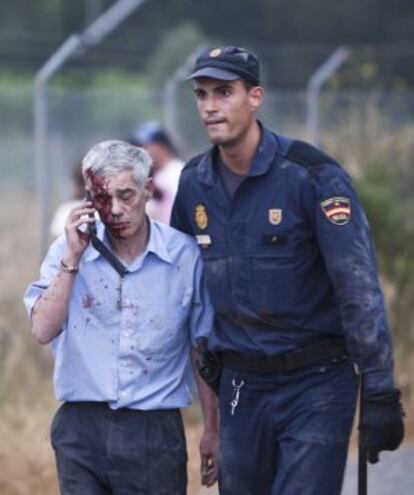“If I’d seen the danger, I wouldn’t have answered the phone”
Testimony from driver and conductor of Alvia disaster confirms theory phone call led to fatal crash

During his second testimony before the judge investigating the fatal rail accident in Galicia on July 24, in which 79 people lost their lives, the driver of the Alvia train, who was appearing at his own request, changed the details of his earlier declaration. Francisco José Garzón told the court that he had been talking to the train’s conductor just before it derailed on a sharp curve between Ourense and Santiago. The driver changed his statement after analysis of the train’s electronic devices revealed that he had spoken on his company cellphone, but he stated that he only picked up because he saw it was the conductor and thought there might have been an emergency.
Garzón told the court that Antonio Martín Marugán and he had spoken about the possibility of entering Pontedeume by the nearest track to facilitate the alighting of passengers, even though the station was still 100 kilometers away and there were various stops beforehand. The driver denied he had been consulting paperwork at the same time, which investigators suspected after studying the sound on the train’s black box recorder.
Garzón was asked several times about the telephone conversation, which the judge and prosecutors believe was the primary cause of the disaster. The conversation between the driver and conductor lasted about two minutes while the train was traveling at 190km/h. Garzón testified that as soon as he hung up he saw he was approaching the fateful curve at Angrois, where the designated speed limit is 80km/h. “When I realized I took both the brakes in my hands. I used the electric one, for the motors, and the pneumatic one, for the brake shoes. Normally, to brake more smoothly, you use the electric one and if needs be, a little of the pneumatic, when you need to brake quickly, you use both at full tilt.”
I told the security people that this curve was dangerous and this could happen”
Asked by the prosecutor where his concentration was during the conversation, Garzón admitted he lost track of his location. “At that moment I didn’t see the danger or the reference point, because if I had, obviously I would have attended to that first and left the phone. But I didn’t see the reference point, I didn’t think it was close, I was going along at a correct speed that didn’t mean any danger. I don’t know if the call had any influence or not.”
Garzón did not place any blame on the signaling system or the track for the disaster, and repeated several times that he would not have answered the phone had it not been his supervisor. However, when calling the emergency services immediately after the crash, the driver said: “I told the security people that this curve was dangerous and that this could happen.” At that stage, Garzón did not know the extent of the tragedy and asked after the passengers several times.
Marugán said in his initial testimony that he had only called Garzón once, when the train was stationary in Ourense. But when presented with the evidence of the second call he admitted the conversation about the approach to Pontedeume. After being informed that his declaration could constitute a crime of false testimony, Marugán remained adamant that he could not remember the time of the call he placed to Garzón. Investigators are convinced that the call ended exactly 11 seconds before the train slammed into a concrete wall on the Angrois bend at 8.41pm, but the conductor says he only recalls speaking to Garzón “sometime after 8pm.”
Marugán was dismissed by the court without any charges. Garzón faces 79 counts of reckless homicide and other violations related to the injuries of at least 170 other passengers, all stemming from alleged professional negligence.
Tu suscripción se está usando en otro dispositivo
¿Quieres añadir otro usuario a tu suscripción?
Si continúas leyendo en este dispositivo, no se podrá leer en el otro.
FlechaTu suscripción se está usando en otro dispositivo y solo puedes acceder a EL PAÍS desde un dispositivo a la vez.
Si quieres compartir tu cuenta, cambia tu suscripción a la modalidad Premium, así podrás añadir otro usuario. Cada uno accederá con su propia cuenta de email, lo que os permitirá personalizar vuestra experiencia en EL PAÍS.
¿Tienes una suscripción de empresa? Accede aquí para contratar más cuentas.
En el caso de no saber quién está usando tu cuenta, te recomendamos cambiar tu contraseña aquí.
Si decides continuar compartiendo tu cuenta, este mensaje se mostrará en tu dispositivo y en el de la otra persona que está usando tu cuenta de forma indefinida, afectando a tu experiencia de lectura. Puedes consultar aquí los términos y condiciones de la suscripción digital.
Últimas noticias
How Japan is trying to avert ‘digital defeat’
The complicated life of Francesca Albanese: A rising figure in Italy but barred from every bank by Trump’s sanctions
Half of Scotland is in the hands of 420 property owners
From digital curfews to blocking apps: How technology experts protect their children online
Most viewed
- Why we lost the habit of sleeping in two segments and how that changed our sense of time
- Pablo Escobar’s hippos: A serious environmental problem, 40 years on
- Trump’s obsession with putting his name on everything is unprecedented in the United States
- The Florida Keys tourist paradise is besieged by immigration agents: ‘We’ve never seen anything like this’
- Charles Dubouloz, mountaineering star, retires at 36 with a farewell tour inspired by Walter Bonatti








































